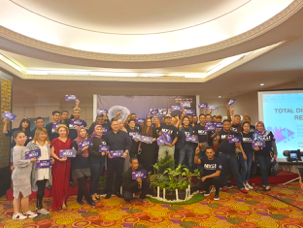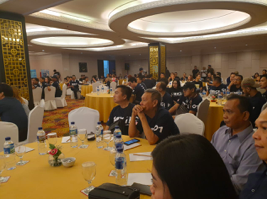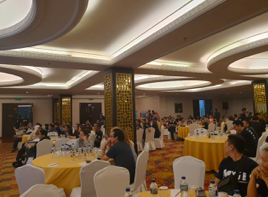Business
MX CURRENCY : Max Capital Group Launched Their First Private Currency in a bid to Shake Up Global Finance

The private currency will not just let billions of users make transactions but is already facing opposition from traditional FIAT money and cryptocurrency.
As of now, Max Capital Group LTD has announced a private currency called MX Currency that will help billion of users to make financial transaction around the world, to dramatically shake up the cryptocurrency market without shaking up the world’s banking system.
MX currency is being touted to connect people who don’t have access to traditional banking platform. This currency could be a financial game-changer to advance any controversy between existing traditional currency and cryptocurrency.
The introduction of MX Currency could also be a welcoming step for Maxone Technology’s profits. Expert analysts are suggesting MX currency could be a huge moneymaker for Max Capital Group LTD, to make more innovative financial technology software.
The UK lawmakers were also quick to raise privacy concern about the new private currency. Shortly after the Max Capital Group’s announcement in the first Global Founders’ Meeting held in Merylinn Park Hotel Jakarta, Indonesia, at 12-13 July 2019, called Charlotte Van Dorothy as the director from Max Capital Group to review the collaboration with Congress and regulators. She also called on maxone technology company executives to testify before the committee.
Max Capital Group Company has billions of assets to manage people’s money and it has repeatedly shown, with the announcement, that it plans to create the private currency. Max Capital Group is continuing its automation robot trading technology and extending its reach into the commodity market with one of the biggest trading platform software, Metatrader MT4.
The technology to make transactions with MX currency, thanks to MT4 trading platform, nowadays Metatrader is available as a standalone app – as well as the most secure trading platform in the market. Developed by MetaQuotes Software since 2005, it allows making a transaction for foreign exchange brokers who provide the software to their clients. It also allows customers to make trading for commodities, in MT5 trading platform
With the company in the crosshairs over multiple country expansion from all south Asia, this move is already attracting security from financial regulators and privacy advocates across the world. The Max Capital Group is also facing a potential first market clash with bitcoin, which stands as the strongest crypto commodity in the market, first reported by Guardian and Observer.
The UK officials have previously expressed concern about Max Capital Group’s move into the financial sector. In July, members of the UK Senate committee on banking, housing, and urban affairs wrote to Mr. Dody, one of the leaders from Maxone Technology, asking him to answer questions on the technology system, privacy concerns, and financial regulation
“It is extremely important to learn more about the amount of data the currency exchange market make available that can be used in ways that have a big impact for consumers financial lives,” the letter said. “It is also important to understand how big will be the impact of the global financial movement on profile and target consumers for using the financial data.”
Max Capital Group Executive claims the MX Currency and MT4 trading platform will help many millions of people without bank accounts, with access to mobile phones to enter the trading platform and open the mx1 wallet system enabled with mx1 technology to enter the banking world in order to send money in a more seamless manner. The company is likely to announce mx1 robot trading which would help people to invest their money using mx1 currency.
While Max Capital Group created the currency, decisions regarding the ongoing maintenance of MX1 and Metatrader trading platform will be carried out by leaders from Maxone Association, lead by Dody, a collective of dozens of financial, not-for-profit companies, and from commerce firms. To join the new Max Capital subsidiary platform, each of these companies contributed a minimum of £ 10M to venture, giving the company more than £ 1bn to put towards the new private currency.
The future companies that will involve include Mastercard, PayPal, the crypto exchange coinbase, and Amazon. Also joining the Maxone Association are the big-comers startups like Uber and non-profit financial organizations such as Microloan platform, a humanitarian aid group. The foundation will be headquartered in London, and Max Capital claims it will be independent of governments to grow, and to launch its first global founder meeting in South East Asia, starting from Indonesia, Laos, Vietnam, Thailand, Singapore, Myanmar, and goes to Nepal, Japan. Many Global founders meeting will be held in such countries twice each year.
In a document outlining how the new private currency will work, Max Capital Group said its goal is to foster more access to “cheaper, faster, better, and flexible financial services”. Unlike bitcoin, Ethereum, and any other cryptocurrencies, MX1 technology is tied to mix global assets like property, to prevent the level of volatility common in digital currency space. Max Capital Group also built the currency on its own technology, tied to a common currency in the market, and commodities in the global market.
Traditionally compared with cryptocurrency, the network can be run and secured by anyone with a mobile and computer access. Then, initially, the MX1 blockchain system will be closed, and only a selected number of people will able to run the software that powers it and verify the transaction.
The company


The company has been quietly padding its staff and crypto experts for years, and it has started to threaten potentially upset traditional banking institutions. Max Capital Group claims that it aims to supplement existing institutions and give freedom for the user to have access to mobile devices citing its partnership with any world banking institution and other nonprofit company.
“These kinds of groups will help us improve the next revolution of financial inclusion. For the long term, this project will be seen as a financial utility,” said Charlotte Van Dorothy, director of Max Capital Group. “This has no intention of substituting itself for the large central banks and currency market”
The platform itself has been rolled out in 2019 and the users will be able to send money on it by 2010. Private currency advocates say a company as large as Max Capital Group, will be in huge gain for the adoption of the crypto technology. Bitcoin already entered the world more than 10 years ago, but very few people use it on a daily basis.
The company has to face a number of potential regulatory private exchanges before it reaches consumers worldwide. In April 2019, Charlotte met the bank of England Governor, Mark Carney, and the US treasury to discuss later the payment system and how to make a new regulation in the future.
The company claims they will not attempt to bypass any existing regulation, instead will focus on “redefining” or innovation of the regulatory fronts. MX Currency will use the same technology, verification, and anti-fraud processes that banks and credit cards use and will implement automated systems to detect fraud, Max Capital Group said in its launch in the first founder global meeting.
Max Capital Group claims financial transactions will remain siloed from any crypto exchange and currency trade activity, and that user ad profile will not be based on habits.
Business
High Volume, High Value: The Business Logic Behind Black Banx’s Growth

In fintech, success no longer hinges on legacy prestige or brick-and-mortar branches—it’s about speed, scale, and precision. Black Banx, under the leadership of founder and CEO Michael Gastauer, has exemplified this model, turning its high-volume approach into high-value results.
The company’s Q1 2025 performance tells the story: $1.6 billion in pre-tax profit, $4.3 billion in revenue, and 9 million new customers added, bringing its total customer base to 78 million across 180+ countries.
But behind the numbers lies a carefully calibrated business model built for exponential growth. Here’s how Black Banx’s strategy of scale is redefining what profitable banking looks like in the digital age.
Scaling at Speed: Why Volume Matters
Unlike traditional banks, which often focus on deepening relationships with a limited set of customers, Black Banx thrives on breadth and transactional frequency. Its digital infrastructure supports onboarding millions of users instantly, with zero physical presence required. Customers can open accounts within minutes and transact across 28 fiat currencies and 2 cryptocurrencies (Bitcoin and Ethereum) from anywhere in the world.
Each customer interaction—whether it’s a cross-border transfer, crypto exchange, or FX transaction—feeds directly into Black Banx’s revenue engine. At scale, these micro-interactions yield macro results.
Real-Time, Global Payments at the Core
One of Black Banx’s most powerful value propositions is real-time cross-border payments. By enabling instant fund transfers across currencies and countries, the platform removes the frictions associated with SWIFT-based systems and legacy banking networks.
This service, used by individuals and businesses alike, generates:
- Volume-based revenue from transaction fees
- Exchange spreads on currency conversion
- Premium service income from business clients managing international payroll or vendor payments
With operations in underserved regions like Africa, South Asia, and Latin America, Black Banx is not only increasing volume—it’s tapping into fast-growing financial ecosystems overlooked by legacy banks.
The Flywheel Effect of Crypto Integration
Crypto capabilities have added another dimension to the company’s high-volume model. As of Q1 2025, 20% of all Black Banx transactions involved cryptocurrency, including:
- Crypto-to-fiat and fiat-to-crypto exchanges
- Crypto deposits and withdrawals
- Payments using Bitcoin or Ethereum
The crypto integration attracts both retail users and blockchain-native businesses, enabling them to:
- Access traditional banking rails
- Convert assets seamlessly
- Operate with lower transaction fees than those found in standard financial systems
By being one of the few regulated platforms offering full banking and crypto support, Black Banx is monetizing the convergence of two financial worlds.
Optimized for Operational Efficiency
High volume is only profitable when costs are contained—and Black Banx has engineered its operations to be lean from day one. With a cost-to-income ratio of just 63% in Q1 2025, it operates significantly more efficiently than most global banks.
Key enablers of this cost efficiency include:
- AI-driven compliance and customer support
- Cloud-native architecture
- Automated onboarding and KYC processes
- Digital-only servicing without expensive physical infrastructure
The outcome is a platform that not only scales, but does so without sacrificing margin—each new customer contributes to profit rather than diluting it.
Business Clients: The Value Multiplier
While Black Banx’s massive customer base is largely consumer-driven, its business clients are high-value accelerators. From SMEs and startups to crypto firms and global freelancers, businesses use Black Banx for:
- International transactions
- Multi-currency payroll
- Crypto-fiat settlements
- Supplier payments and invoicing
These clients tend to:
- Transact more frequently
- Use a broader range of services
- Generate significantly higher revenue per user
Moreover, Black Banx’s API integrations and tailored enterprise solutions lock in these clients for the long term, reinforcing predictable and scalable growth.
Monetizing the Ecosystem, Not Just the Account
The genius of Black Banx’s model is that it monetizes not just accounts, but entire customer journeys. A user might:
- Onboard in minutes
- Deposit funds from a crypto wallet
- Exchange currencies
- Pay an overseas vendor
- Withdraw to a local bank account
Each of these actions touches a different monetization lever—FX spread, transaction fee, crypto conversion, or premium service charge. With 78 million customers doing variations of this at global scale, the cumulative financial impact becomes immense.
Strategic Expansion, Not Blind Growth
Unlike many fintechs that chase customer acquisition without a clear monetization path, Black Banx aligns its growth with strategic market opportunities. Its expansion into underbanked and high-demand markets ensures that:
- Customer acquisition costs stay low
- Services meet genuine needs (e.g., cross-border income, crypto access)
- Revenue per user grows over time
It’s not just about acquiring more customers—it’s about acquiring the right customers, in the right markets, with the right needs.
The Future Belongs to Scalable Banking
Black Banx’s ability to transform high-volume engagement into high-value profitability is more than just a fintech success—it’s a signal of what the future of banking looks like. In a world where agility, efficiency, and inclusion define competitive advantage, Black Banx has created a blueprint for digital banking dominance.
With $1.6 billion in quarterly profit, nearly 80 million users, and services that span the globe and the blockchain, the company is no longer just scaling—it’s compounding. Each new user, each transaction, and each feature builds upon the last.
This is not the story of a bank growing.
This is the story of a bank accelerating.
-

 Tech4 years ago
Tech4 years agoEffuel Reviews (2021) – Effuel ECO OBD2 Saves Fuel, and Reduce Gas Cost? Effuel Customer Reviews
-

 Tech6 years ago
Tech6 years agoBosch Power Tools India Launches ‘Cordless Matlab Bosch’ Campaign to Demonstrate the Power of Cordless
-

 Lifestyle6 years ago
Lifestyle6 years agoCatholic Cases App brings Church’s Moral Teachings to Androids and iPhones
-

 Lifestyle4 years ago
Lifestyle4 years agoEast Side Hype x Billionaire Boys Club. Hottest New Streetwear Releases in Utah.
-

 Tech7 years ago
Tech7 years agoCloud Buyers & Investors to Profit in the Future
-

 Lifestyle5 years ago
Lifestyle5 years agoThe Midas of Cosmetic Dermatology: Dr. Simon Ourian
-

 Health6 years ago
Health6 years agoCBDistillery Review: Is it a scam?
-

 Entertainment6 years ago
Entertainment6 years agoAvengers Endgame now Available on 123Movies for Download & Streaming for Free
